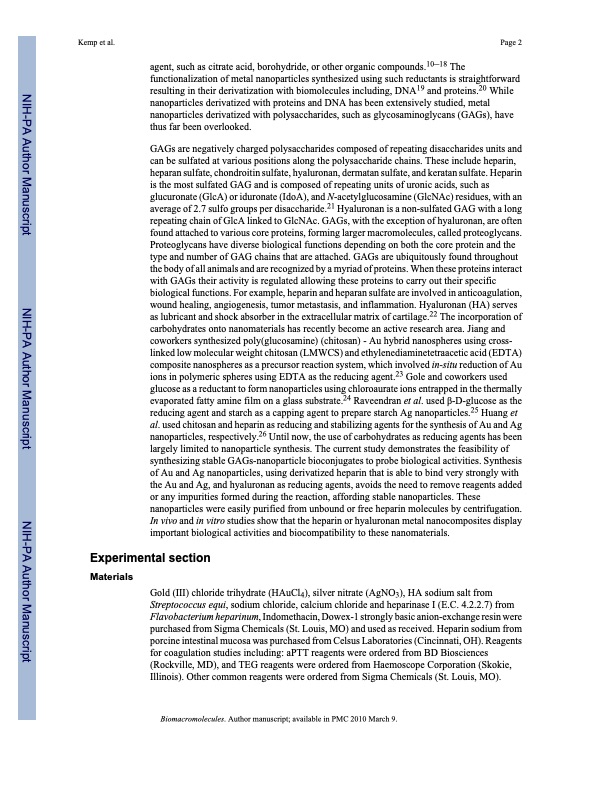
PDF Publication Title:
Text from PDF Page: 002
Kemp et al. Page 2 agent, such as citrate acid, borohydride, or other organic compounds.10–18 The functionalization of metal nanoparticles synthesized using such reductants is straightforward resulting in their derivatization with biomolecules including, DNA19 and proteins.20 While nanoparticles derivatized with proteins and DNA has been extensively studied, metal nanoparticles derivatized with polysaccharides, such as glycosaminoglycans (GAGs), have thus far been overlooked. GAGs are negatively charged polysaccharides composed of repeating disaccharides units and can be sulfated at various positions along the polysaccharide chains. These include heparin, heparan sulfate, chondroitin sulfate, hyaluronan, dermatan sulfate, and keratan sulfate. Heparin is the most sulfated GAG and is composed of repeating units of uronic acids, such as glucuronate (GlcA) or iduronate (IdoA), and N-acetylglucosamine (GlcNAc) residues, with an average of 2.7 sulfo groups per disaccharide.21 Hyaluronan is a non-sulfated GAG with a long repeating chain of GlcA linked to GlcNAc. GAGs, with the exception of hyaluronan, are often found attached to various core proteins, forming larger macromolecules, called proteoglycans. Proteoglycans have diverse biological functions depending on both the core protein and the type and number of GAG chains that are attached. GAGs are ubiquitously found throughout the body of all animals and are recognized by a myriad of proteins. When these proteins interact with GAGs their activity is regulated allowing these proteins to carry out their specific biological functions. For example, heparin and heparan sulfate are involved in anticoagulation, wound healing, angiogenesis, tumor metastasis, and inflammation. Hyaluronan (HA) serves as lubricant and shock absorber in the extracellular matrix of cartilage.22 The incorporation of carbohydrates onto nanomaterials has recently become an active research area. Jiang and coworkers synthesized poly(glucosamine) (chitosan) - Au hybrid nanospheres using cross- linked low molecular weight chitosan (LMWCS) and ethylenediaminetetraacetic acid (EDTA) composite nanospheres as a precursor reaction system, which involved in-situ reduction of Au ions in polymeric spheres using EDTA as the reducing agent.23 Gole and coworkers used glucose as a reductant to form nanoparticles using chloroaurate ions entrapped in the thermally evaporated fatty amine film on a glass substrate.24 Raveendran et al. used β-D-glucose as the reducing agent and starch as a capping agent to prepare starch Ag nanoparticles.25 Huang et al. used chitosan and heparin as reducing and stabilizing agents for the synthesis of Au and Ag nanoparticles, respectively.26 Until now, the use of carbohydrates as reducing agents has been largely limited to nanoparticle synthesis. The current study demonstrates the feasibility of synthesizing stable GAGs-nanoparticle bioconjugates to probe biological activities. Synthesis of Au and Ag nanoparticles, using derivatized heparin that is able to bind very strongly with the Au and Ag, and hyaluronan as reducing agents, avoids the need to remove reagents added or any impurities formed during the reaction, affording stable nanoparticles. These nanoparticles were easily purified from unbound or free heparin molecules by centrifugation. In vivo and in vitro studies show that the heparin or hyaluronan metal nanocomposites display important biological activities and biocompatibility to these nanomaterials. Experimental section Materials Gold (III) chloride trihydrate (HAuCl4), silver nitrate (AgNO3), HA sodium salt from Streptococcus equi, sodium chloride, calcium chloride and heparinase I (E.C. 4.2.2.7) from Flavobacterium heparinum, Indomethacin, Dowex-1 strongly basic anion-exchange resin were purchased from Sigma Chemicals (St. Louis, MO) and used as received. Heparin sodium from porcine intestinal mucosa was purchased from Celsus Laboratories (Cincinnati, OH). Reagents for coagulation studies including: aPTT reagents were ordered from BD Biosciences (Rockville, MD), and TEG reagents were ordered from Haemoscope Corporation (Skokie, Illinois). Other common reagents were ordered from Sigma Chemicals (St. Louis, MO). Biomacromolecules. Author manuscript; available in PMC 2010 March 9. NIH-PA Author Manuscript NIH-PA Author Manuscript NIH-PA Author ManuscriptPDF Image | Gold and Silver Nanoparticles Stabilized Glycosaminoglycans

PDF Search Title:
Gold and Silver Nanoparticles Stabilized GlycosaminoglycansOriginal File Name Searched:
nihms96339.pdfDIY PDF Search: Google It | Yahoo | Bing
Turbine and System Plans CAD CAM: Special for this month, any plans are $10,000 for complete Cad/Cam blueprints. License is for one build. Try before you buy a production license. More Info
Waste Heat Power Technology: Organic Rankine Cycle uses waste heat to make electricity, shaft horsepower and cooling. More Info
All Turbine and System Products: Infinity Turbine ORD systems, turbine generator sets, build plans and more to use your waste heat from 30C to 100C. More Info
CO2 Phase Change Demonstrator: CO2 goes supercritical at 30 C. This is a experimental platform which you can use to demonstrate phase change with low heat. Includes integration area for small CO2 turbine, static generator, and more. This can also be used for a GTL Gas to Liquids experimental platform. More Info
Introducing the Infinity Turbine Products Infinity Turbine develops and builds systems for making power from waste heat. It also is working on innovative strategies for storing, making, and deploying energy. More Info
Need Strategy? Use our Consulting and analyst services Infinity Turbine LLC is pleased to announce its consulting and analyst services. We have worked in the renewable energy industry as a researcher, developing sales and markets, along with may inventions and innovations. More Info
Made in USA with Global Energy Millennial Web Engine These pages were made with the Global Energy Web PDF Engine using Filemaker (Claris) software.
Infinity Turbine Developing Spinning Disc Reactor SDR or Spinning Disc Reactors reduce processing time for liquid production of Silver Nanoparticles.
| CONTACT TEL: 608-238-6001 Email: greg@infinityturbine.com | RSS | AMP |